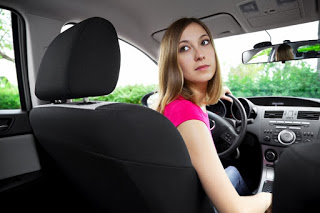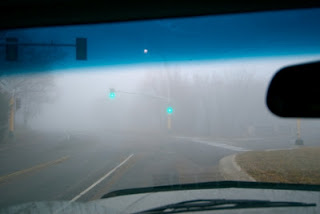Tag Archive: driver training

Tips for Proper Parallel Parking
July 14, 2011
Probably, the maneuver that most strikes fear in the heart of a new driver facing a behind-the-wheel driving test, is the parallel parking maneuver. Maneuvering your vehicle, backwards, into a tiny parking spot without hitting the vehicle ahead or behind is daunting even for experienced drivers who don’t have to do it very often but it doesn’t have to be all that scary. Just like any other skill, all it takes is practice…. lots and lots of practice.
You shouldn’t start practicing in a real environment with actual cars in front and back; making a mistake while learning to park around real cars could be costly. Instead, you should begin learning how to perform this maneuver in an empty parking lot with a pair of cones or some other type of marker to represent the front and rear bumpers of the car ahead and behind.
Step one – Illuminate your right turn signal to let other drivers know your intentions. Slow down and pull up alongside the other “car” (cone) until your rear bumper is even with the front vehicle’s rear bumper. Check your mirrors for other traffic and don’t begin until you are sure the way is clear.
Step two – Put the car in reverse and turn the wheel to the right. Turn the upper part of your body to the right so that you can clearly see everything behind you. Start backing slowly and steadily into the space behind. When your passenger door comes even with the rear bumper of the front vehicle, stop.
Step three – Turn the steering wheel to the left and continue backing into the space making sure you aren’t coming too close to the vehicle ahead or about to hit the bumper of the vehicle behind. Once your front bumper has completely cleared the vehicle ahead and your car is completely in the space, stop the car.
Step four – Now put the gear shift into drive and ease the car forward until you are completely centered in the space with enough clear space ahead and behind for you to get out later.
Step five – Put the car in park and get out to see if your car is fully centered. There should be roughly, an even amount of space between your vehicle and the vehicles ahead and behind. Your car should be facing straight ahead and not parked at an angle and the side of your car should be no more than 12 to 18 inches away from the curb.
Keep practicing this parallel parking maneuver over and over until it is second nature to you. With enough practice, you will be able to dazzle the DMV examiner with your skill and confidence.

Tips for Teens: When is the Speed Limit too Fast for Conditions?
July 15, 2010
Many teens are so excited to get their driver’s licenses that much of the training they received prior to licensure is quickly forgotten. But it’s important for new drivers to follow the fundamental rules of the road, and adapting speed to conditions is one rule that’s frequently broken.
Driving too fast for conditions is considered speeding and can result in a traffic ticket. But that’s not the only reason to slow down – driving too fast for conditions is a contributing cause of many motor vehicle crashes. Motor vehicle crashes are the leading cause of death for 15- to 20-year-olds (based on 2005 figures, which are the latest mortality data currently available from the National Center for Health Statistics).
A 2009 analysis of speeding-related crashes by the National Highway Traffic Safety Administration (NHTSA) shows that following the speed limit is not enough to prevent a crash when conditions warrant a reduction in speed. The study showed that in speeding-related crashes that caused one or more injuries, 26% of the crashes were contributed to be exceeding the posted speed limit, while 74% were due to driving too fast for conditions. In property-damage-only crashes where speed was a contributing factor, 18% of the crashes were due to exceeding the posted speed limit and 82% of the crashes were contributed to by driving too fast for conditions.
Drivers should reduce their speed:
-immediately when it begins to rain. Roads become very slippery just after the rain begins, because the rainwater mixes with oil on the road that has been dropped from passing vehicles. Driving too fast on wet roads can result in skidding, when the vehicle loses traction with the road and the driver loses control of the vehicle.
-when roads are slippery due to snow or ice. Vehicles have even less traction on snowy or icy roads than they have in rainy weather. On icy roads, drivers should slow to a crawl and get off the road as soon as possible.
–in foggy or smoky conditions. Fog and smoke make it difficult to see ahead, and reducing speed reduces stopping distance.
-before a curve. Too often, drivers realize that they are moving too fast when they are already in the curve, but lowering speed in a curve results in a loss of traction that could cause a skid. Always reduce speed before entering the curve.
-in construction zones. Lower speed limits are usually posted in construction zones, but the new speed limit may not be low enough, especially for new drivers. The distraction of all the activity in the work zone and changes in the road surface can cause more difficulties for drivers who are inexperienced.
-around school zones and playgrounds. Again, lower speed limits are posted in school zones, but children are often present when the lowered limits are not in effect. Children are unpredictable and may walk, skate or bike into the road without checking for traffic.
-at night. Visibility is reduced at night; street lights and the vehicle’s headlights cannot entirely make up for this.
It’s also important to monitor your speed carefully on rural roadways with higher speed limits. Since the speed limit is already high, it’s easy to drive too fast for conditions, which often include curves, animals, farm equipment, and roads that are not well-maintained.
Pressure from teen passengers should also be considered. Passengers may encourage the driver to travel at or above the speed limit. Resisting this pressure is an important exercise in maturity for teen drivers and is an integral part of keeping their driver’s licenses. Unfortunately, it could even be a life-and-death matter.
Teaching Your Teen To Drive During the Christmas Holiday Season
December 14, 2009
The Christmas season is supposed to bring out the best in us but, for drivers, it seems to bring out the worse. The mad rush to commute from work, get to the mall, and complete our shopping in a reasonable amount of time, makes this season one of the most dangerous driving periods of the year. With the arrival of the Christmas shopping season, parents, whose children are learning to drive on a learner’s permit, may be reluctant to let their teen drive in such a crazy driving environment.
Only you can decide whether or not your teen may be prepared to drive during this season. For a teen who only has a month or so of driving experience, it is probably not a good idea to allow them to drive in heavy Christmas traffic. However, for a teen with a good deal of driving experience, it is probably the best time to allow them to drive while you are in the seat next to them to give them guidance. This season presents a great teaching experience and an opportunity to open up a dialogue about how not to drive.
Before you and your teen venture out to the mall, you would be wise to discuss the driving environment and let the teen know what he or she can expect. You will need to exercise a great deal of patience, both with each other and with the other drivers on the road.
What kind of driving experiences and teaching moments can you and your teen expect?
Other Drivers
This season brings out the worst in drivers. If a driver cuts you off, tries to steal your parking space, or is honking the horn when you can’t move, don’t give into the urge to retaliate by gestures, honking your horn, or flashing your lights. You may wind up pushing an irate driver over the edge into a road rage situation where the other driver may try to attack you in some way. Both you and your teen should keep your cool, pay attention to your own safety and get out of the way of an irate driver as quickly as you can.
Remember that you can’t take the right-of-way, you can only give it up to someone else. If there is a conflict with another driver trying to take the right-of-way, it is much safer to give it to them.
Intersections
Several problems will be encountered at intersections. First, and most dangerous, will be those impatient drivers who will step on the gas in hopes of beating a red light. Many drivers will deliberately run the red light. Once your light turns green, don’t be in a hurry to go. Have your teen look in all directions to make sure that no one is trying to run the red light before proceeding.
The other issue you will have to contend with are those drivers who pull forward into intersections when traffic ahead is stopped and wind up blocking the intersection when the light changes. Your teen will need to stop at the stop line before the intersection and wait until traffic ahead has cleared enough to allow her to proceed completely through the intersection.
Pedestrians
There is probably no time of year where we encounter more pedestrians on the road. Remember that pedestrians in a crosswalk, whether marked or not, always have the right-of-way. Pedestrians can’t move as fast as a car can, especially when they are burdened down with packages, so don’t expect them to jump out of your way. Remember also that pedestrians may not hear you coming. Their minds are occupied just like yours. Their ears may be wrapped in a muffler or a hat or the pedestrian could be totally deaf.
Be careful and have a safe and enjoyable holiday season.
Additional Driver Safety Tips for the Holiday Seasons:
http://alerts.nationalsafetycommission.com/2009/10/holiday-driving-halloween-safety-tips.php
http://alerts.nationalsafetycommission.com/2009/11/thanksgiving-traffic-safety-2009.php

Driver Education: Traffic Safety for New High School Graduates
June 5, 2009
Summer is here and school is out. Many young drivers will be spending more time on the road going to the beach or pool, working at summer jobs, and having fun with friends. This is an especially exciting time for teens who are 2009 high school graduates. Recent grads are filled with elation, a sense of freedom, and hopes and dreams for the future. But euphoria and increased independence can cause problems when they lead relatively inexperienced drivers to take chances behind the wheel. And summertime is a dangerous time for drivers in general; traffic deaths for all drivers increase during the warm-weather months, peaking in July.
Three deadly holidays take place during the summer – Memorial Day, the Fourth of July, and Labor Day. According to the National Center for Statistics and Analysis, in a 2004 analysis of six holiday periods, the average number of traffic deaths during holiday periods was 156 per day, compared to 117 per day on non-holidays. According to the National Highway Traffic Safety Administration, 20 of the 25 deadliest days on US roads over a five-year time frame fell during the period from Memorial Day weekend to Labor Day.
Teen motor vehicle fatalities are also highest in the summer, partly because it’s an unsafe time for all drivers, but also due to risk factors specific to young drivers. Like other drivers, teens spend more time on the road during the summer (averaging 44% more hours driving each week, according to the NHTSA) and are more likely to drive at night. But they lack the experience of older drivers in dealing with heavy traffic and low-visibility conditions. Like other drivers, teens behind the wheel in the summer are often accompanied by multiple passengers. But teens are often much more distracted by their passengers than older drivers, and they are unlikely to assert themselves even when they are aware that they need to concentrate on driving.
Parents who want their teens to survive the summer must stay involved in their teens’ driving activities. Without close supervision, the vast majority of teens lack the emotional maturity to stay safe behind the wheel – or as passengers of other teen drivers.
-Though most parents will broaden driving privileges for summer, avoid giving teens too many privileges at once. Extend privileges one at a time and make sure teens prove they can handle the increased responsibility before adding more.
-Conduct supplementary driver training lessons. For example, many teens have limited experience with night driving during the school year; a few lessons will help them learn good nighttime driving habits from the beginning. A teen driving checklist helps parents provide valuable feedback on the driving lesson.
-A driver training course will help teens review fundamental driving concepts during a time when they are most at risk. A quick safe-driving refresher could help an inexperienced young driver make the right choice in an emergency. Parents whose teens receive even one traffic ticket must address the issue immediately; tickets mean teens are probably engaging in more risky driving behaviors than parents realize.
-Parents should check up on their teens’ seat belt use as often as possible. In 2006, the NHTSA reported that 58% of 16- to 20-year olds who were involved in fatal motor vehicle collisions were not wearing seat belts. The Insurance Institute for Highway Safety reports that teen seat belt use increases over time when strict parental limits are set.
-A heightened level of awareness about their teens’ access to alcohol, particularly on holidays, is critical for concerned parents. Teens may even have access to alcohol via their friends’ parents; ensure that teens understand that underage drinking is never acceptable, no matter what any other parent says or does, even for a special occasion. Create a codeword so your teen can ask to be picked up without risking the ridicule of friends.

How Teens Can Drive Safely on the Expressway
June 9, 2009
A complete driver-training program includes lessons on all types of streets and highways, both night and day, in a variety of weather and traffic conditions. But many teens get the majority, if not all, of their driver training on familiar roads close to home. Some young drivers do not make their first expressway trip until after they are licensed and driving on their own. This is a high-risk method for teens to gain driving experience, because:
Commentary driving is an excellent way to train teens to drive safely on the expressway. With commentary driving, teens maintain a running dialogue of their progress – what they notice as they observe the roadway and what actions they will take: “The car in front of me is slowing down, so I’m slowing down and checking my following distance. My exit is coming up in one mile, so I’m putting on my turn signal, checking my mirrors and blind spot, and moving into the exit lane. The exit ramp has a posted speed limit of 45 mph, so I’m slowing to that speed. It’s starting to rain, so I’m increasing my following distance.”
Commentary driving forces the driver to use critical thinking skills to make driving decisions. The fact that the driver’s observations are verbalized is comforting to the person (typically a parent) teaching the teen to drive, because it allows the instructor to follow the teen’s thought process and quickly make corrections without lecturing, which teens tend to tune out anyway.
Teens often feel awkward about commentary driving, so it is helpful to model it for them prior to beginning driving lessons. This also allows parents to perfect the process and to see the roadway with new eyes, thus relating better to the beginning driver.
From a practical standpoint, it is obviously important for teens to work up to practicing driving on the expressway. The first several lessons should occur during non-peak hours on dry roads during the daytime. Introduce one variable – nighttime hours, rainy weather, rush-hour traffic – at a time, and ensure the teen is completely comfortable with each before progressing to the next.
The following training tips will help teens be safer drivers on the freeway: